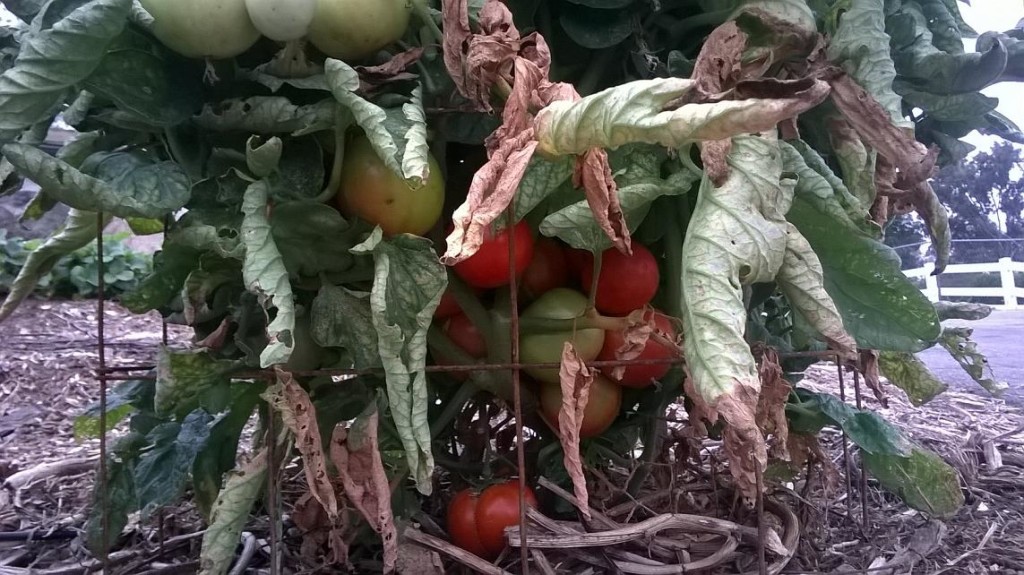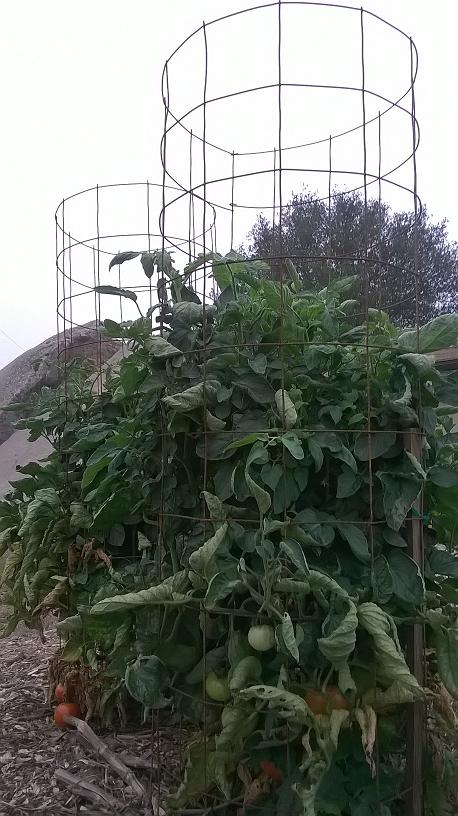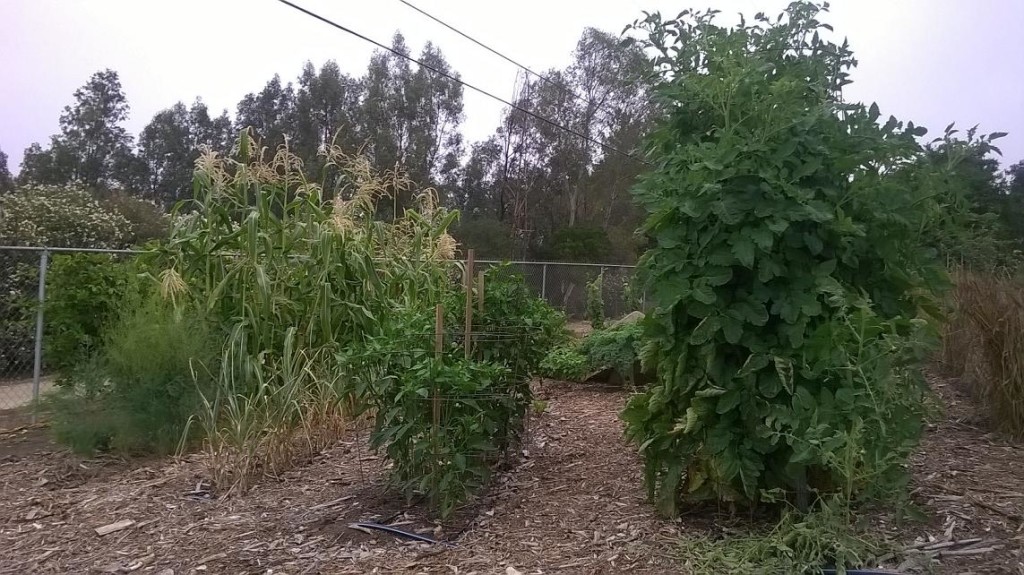‘San Diego’ tomatoes
I shouldn’t be surprised, but the variety of tomato called ‘San Diego’ is thriving here in . . . San Diego. Why did I wait until this year to try it? Compared to the other varieties I’ve grown in this yard — including Ace, Better Boy, Pineapple, San Marzano, Costoluto Genovese, Kellogg’s Breakfast, Early Girl, Juliet, and Brandywine — the San Diego variety is just as productive or more so, has nice color, no sunburn, and very little cracking. I’m also pleased with the taste.
Vince Lazaneo, former horticulture advisor with the University of California Cooperative Extension in San Diego, told me of the origins of this variety: “The tomato variety sold as San Diego hybrid is a numbered variety 7718. It originated in a research trial by farm adviser Bernard Hall, who started with UC Extension in San Diego County after WWII. He was still working in our County office when I joined in 1977. Sometime before that though, he had a field trial with different tomato varieties from various breeders. A new fungal disease swept through the County and destroyed most of the tomatoes being grown at the time. The variety 7718 in Hall’s trial, was not affected and it was used to breed with other varieties to acquire the resistance to the fungal pathogen . . . that’s the story as I know it. The commercial veg growers were very thankful to Hall and gave him a nice gift when he retired.”
Indeed, you can find the variety listed in a publication by UC Davis about growing tomatoes in California: “7718VF (aka San Diego Hybrid); large, semideterminate plant grown with stake or cage; widely adapted with large fruit.”
Fedco Seeds says this is about ‘San Diego’ tomatoes: “Won our taste test of determinate hybrids.”
Supporting tomatoes
Another “why did I wait until this year to finally . . .” relates to the support I’m giving all of my tomatoes. This year I invested in real cages, the kind you have to build yourself. I’d tried every simple and cheap method in the past: I tied them onto the chain link fence, I let them sprawl wild on the ground, I fastened them to a stake, I twisted them up a string attached to the eaves, and of course I tried the little wire tunnels they sell as tomato cages. None of those methods satisfied, either because they couldn’t contain a vigorously growing tomato plant (little cages), because they require too much training (strings on eaves), or because they make harvest a pain (sprawling wild over the ground). So I forked over $98 at the hardware store for a roll of steel mesh (used in reinforcing concrete) and made cages that are five feet tall and two feet in diameter.
In April, when a visitor saw the baby tomato plants inside the huge cages she joked that I might be overly ambitious. But here we are in early July and many of the plants have already gone a foot over the top of the cages, such as these ‘San Marzano’ plants — they’re as tall as my corn!






I to love the San Diego variety. i grew it exclusively when I lived in Riverside, CA. i now live in Hilo, HI. Where can I get seeds for San Diego?
Hi Ron,
I’ve never seen seeds available for the ‘San Diego’ variety of tomato. I’ve always only seen transplants for sale. I don’t know why. I’ll look into it.
I just got a San Diego tomato plant at the Dollar Tree in Simi Valley. It’s super sturdy and healthy. It was a dollar.
What store do you typically find the transplants at?
Thanks,
Jess
You can order the San Diego variety of seeds from Vis Seed Company in Arcadia, CA. I just did, and they were very accommodating.
WHERE can I buy them, I live in North San Diego county, please, I need to plant them pronto
Hi Victor,
Walter Andersen Nursery in Poway had six packs of ‘San Diego’ tomatoes a couple days ago, and they carry the variety almost every year.
Just bought some 4 inch starters today at Andersons la Costa in n. County SD
I bought some at grangettos
I just bought six San Diego tomato plants that look very healthy or a lousy 99 cents each at the 99 cent store in Murrieta.. I normally pay $2.99 or more for tomato plants these days they’ve got an expensive.
Hi Ed, have you seen any there this year?
If you’re in San Diego, City Farmers Nursery off Home Avenue has seedlings. They probably have seeds too but I didn’t look.
Two weeks ago, I picked up a couple of healthy looking SD plants at the 99 Cents store. I haven’t planted them yet but they are growing quickly. Does anyone know if they’d be good candidates for pots?
‘San Diego’ tomato plants aren’t the biggest. I’d guess that you could grow a decent plant in a five gallon container.
I just planted two San Diego tomato plants in containers thinking they would grow to be cherry tomato size. I guess they are going to be much bigger than that, which is okay. I hope they do all right. I’d just like to get an idea of approximately what size they will be when they mature. Now I need to find some cherry or grape tomatoes to plant as well! I’m in the San Fernando Valley, CA.
Hi Marilyn,
The ‘San Diego’ tomatoes are medium sized, and the plants are too. Cherry tomatoes always have small fruit, but the plants are usually very big.
If your container is about 15-gallon size, you should be fine with those ‘San Diego’ plants.
Greg–
Thank you! The plants have a couple of tomatoes so far and they look like they are doing fine. I’m looking forward to tasting them!
Marilyn
Greg – How did you secure your changes in the soil?
Hi Karin,
How did I secure the cages? I drove a 1-inch by 1-inch stake into the ground inside the cage and tied the stake to the cage.
I just bought two at the 99cent store gonna plant today already has flower’s
five years ago I ordered San Diego tomato seeds from Vis Seed Company in Arcadia, Ca. Google and you’ll get info about them. They could only sell me a nearly a gram of seeds. They are still viable.
As for the name of this variety, during a slumping tomato economy in the city of San Diego, this was a winner–thus the name. Good luck! Beverley Scray, Corona
I just ordered 2 seed packets (one for a friend) over the phone from Vis Seed Co. in Arcadia. Very nice to deal with, and I’m looking forward to trying the San Diego variety here in Tennessee.
Hi Debbie,
I just called the number for Vis Seed Co. in Arcadia and I was told they are wholesale only. Do you have a number or a catalog? I have been looking for San Diego Tomato seeds for a very long time. Thank you for any information you can provide.
If you’re near North County San Diego, in Fallbrook, Dianne’s Herbs on Mission Rd has a really nice collection of tomato seedlings, including San Diego variety for sale. They also have Phoenix, which are supposed to be very heat tolerant. Lots of other choices ignoring a ton of heirloom variety. $4 each for a seedling in a quart container.
*including. (Sorry, typed that on my phone)
The San Diego tomatoes are now in stock at the .99 cent store – 1/31/2022. They are $1.49 each for a 4 inch pot. Found this thread looking for info on them.
Hi! Curious which .99 cent store? I haven’t seen them anywhere near where I am in Claremont.
I had great luck with this variety a couple of years ago, but can’t seem to find them anywhere this year. Anyone know where a seedling can be found near the Claremont/Pomona area?
I found a San Diego tomato plant at the 99 cent store in Pasadena CA. I can’t wait to plant it with the other variety of tomato plants I’ve bought.
Cool, Dani. I’m also growing ‘San Diego’ this year. Hope yours do well.
I grew “San Diego” variety many years ago, when I lived in Scripps Ranch. Purchased the plant at Walter Anderson Nursery. I had this fun idea of weighing the fruit taken from each of my varieties. From the San Diego plant (not plural!) I stopped weighing the fruit when I surpassed 100 lbs. That was before I tried vertical growing and cutting off the suckers. One plant took up 1/3 of my 4’x12’ raised bed. I used the “erector set” tomato support system, and kept adding stakes and cross arms to support all the growth. I loved that tomato plant! I wish I could find it again.
Hi Greg: Cant wait for your 2024 Tomato post as its March 16? I’ve made most of my selection and will plant next week 3/18~22/24 as warm weather predicted in Oside. I have limited space so I have 5 holes for I’ve chosen Sungold, Sweet 100, Black Cherry “cherry. Then 1 x Momotaro and 2 x 20 gal. Grow bags I’m trying with a Momotaro and a “San Diego” which i found at Terra Bella Nursery in SD. Using Farmer Roys method/recipe in ground. In the Grow bags I splurged on Fox farms soil and will use their liquid fertlizer. The in ground plants will have Roys Bio Flora Dry crumbles 6-6-5. Wish me luck, cant wait for your Tomato Yard Post”. !!!!! BR, Joe
Sounds promising, Joe. You are farther along than me. My tomato plants are still six-pack size and not growing very fast. I don’t see myself planting them this year until early April since the weather doesn’t appear to want to warm yet.
I don’t have a new 2024 tomato post planned. Usually, I do a tomato post at the end of the season when I have some results to show. I intend to do a couple of experiments this summer so I’ll report on those later.
Greg, I just came across this article. Nice job. I found it to be particularly interesting, as I was a young boy living in San Diego County in the early 1970’s. My father, himself a pioneer in drip irrigation at the time, worked closely with Mr. Hall.
Bernard and his wife were truly wonderful people, whom we came to know quite well in those years. To this day, I recall his kind demeanor and the amazement felt as I walked through the treasure trove of plants and trees surrounding their home. It’s so nice to read this acknowledgement of a man who not only devoted his skills and talents to serving others through his work as a farm adviser, but a man whom I fondly remember as a wonderful human being.
Thank you for taking the time to share this, Douglas. It adds an extra personal touch to the story and the tomato variety.